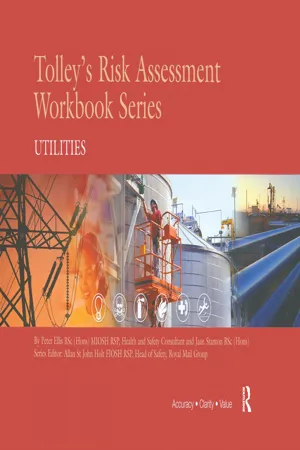
- 184 pages
- English
- ePUB (mobile friendly)
- Available on iOS & Android
Tolley's Risk Assessment Workbook Series: Utilities
About This Book
Risk assessment is the key to successful management of health and safety at work. Risk assessments are carried out in order to quantify and evaluate the significance of workplace hazards so that appropriate control measures can be put in place.Usually, a written record of the assessment is required, detailing the following information:
* The hazards – and how much risk is associated.
* The risk – with appropriate control measures.
* Deadlines – to follow-up the risk assessment to ensure the risk is managed.Failure to carry out risk assessments – punishable by law – is often due to lack of a suitable risk assessment system. Tolley's Risk Assessment Workbook – Utilities provides that system, both in the form of key background information on how to carry out a risk assessment – understanding relevant legislation and regulations – but most importantly by providing:
* Checklists – highlighting key industry-specific hazards and control measures.
* Questionnaires – highlighting key questions the risk assessor should ask when analysing the risk posed by the hazard.
* Action Plans – to ensure the risk assessment is followed up and completed.The Workbook offers a practical risk assessment system: it shows you how to comply with the law and gives you the foundations of a logical procedure that can be understood easily, put into placed quickly where necessary and adapted to your organisation's needs. Tolley's Risk Assessment Workbooks is a series of practical Workbooks providing you with all the information you need to conduct risk assessments in industry-specific areas including: Manufacturing, Retail, Leisure, Education, Offices, and Construction. A special Risk Assessment Workbook on Stress has also been developed in order to facilitate management of this issue which is of key concern to all organisations.
Frequently asked questions
Information
Part I
Introduction
Table of contents
- Cover
- Title Page
- Copyright Page
- Preface
- Table of Contents
- Part 1
- Part 2